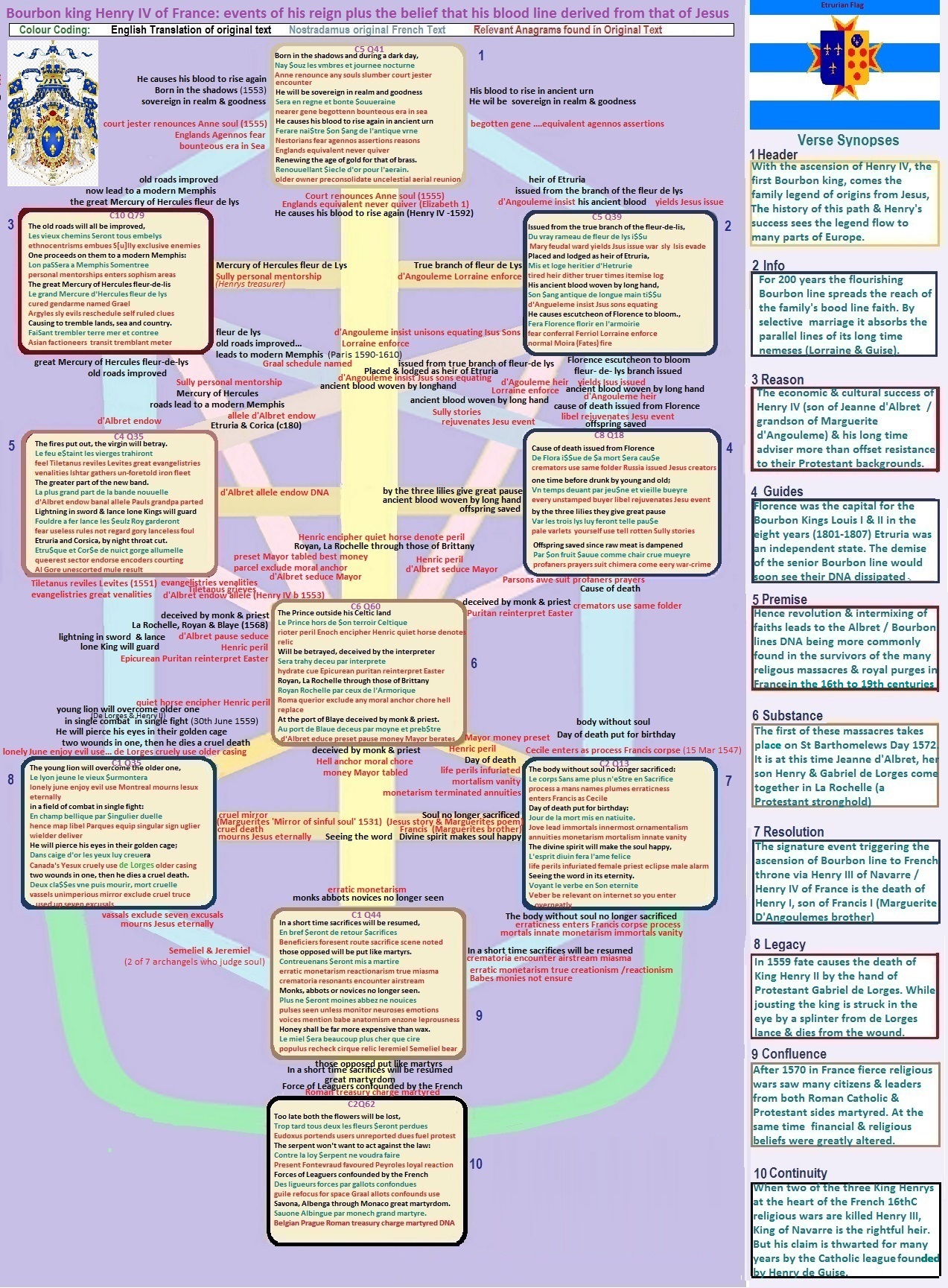 Analyses of all verses
Analyses of all verses
|
 Web Site
Web Site |
 All
Sephirots All
Sephirots |
Nostradamus' 16thC Bourbon lineage theme based in place & people names
© Allan Webber January 2018
It is the purpose of this paper to present the Sephirot Chart of ciphers covering the path by which the supposed bloodline from Jesus is carried in the Bourbon kings and continues to flower up to our modern day.
The verses given below illustrate the claims Nostradamus made about the nature of his Prophecies. In so doing they bring out the elements of the transition of the bloodline by focusing on incidents that have particular popular appeal. As such they don't seem to be part of a theme but when the lettering is examined it is apparent sections tell the secret story of the Protestant cause in the sixteenth century. In the following quote the middle part identifies two major victims perceived in his visions, the institutions of religion and commerce.
All comes from God and nature, and for the most part it is integrated with the celestial course. It is much like seeing in a flaming mirror, where the vision of the great events is clouded, sad, prodigious and calamitous. Events that in due time will fall upon the principal worshippers, firstly upon the temples of God; secondly, upon those who, sustained by the earth, approach such a decadence. Also a thousand other calamitous events which will be known to happen in due time. Henry Epistle 1558 HEE7a
The ciphers of this Sephirot center on the names and places involved with the accession of the Bourbon royal line to the throne of France. It is the tale of an unexpected change in the fortunes of two families whereby the less likely of the two lines gains legal control of the kingdom. This takes place despite its successors and their supporters being identifiable both with the Protestant cause in France and leading the Huguenots in their religious wars with the Catholic League during the 16th and 17th Centuries. The names and places in the text have a very strong correlation with the Royals of the 16th century and the anagrams are also highly potent. For example in C6 Q62 there is an anagram for Fontevraud (tnevoudraf); it is singular in occurrence and is the name of the monastery where members of the Angevin royal line were placed to rest. This is the family line that legend has being derived from Christ's blood line.
|
Frequency of anagrams in this Sephirots verses relating to
names places & terms in 16thC Bourbon line. C5 Q39 1: d'Angouleme, qnouuledge, array, Ysis, 2: Angouleme, minutiae, conferral, Ferriole, ditherer, itemise, 4: equating, La Ferron, feudal uvard, rudely, quieted, 5: normal, 6: their, 7: army, vary, Mary, 8: enforce, 11: Lorraine, 12: Florence, C10 Q79 : 1: mentorships, ethnocentrism, exclusive, pres-seasonal, emphasism, 2: factioneers, reschedule, martinets, sophism, Argyles, bely, 4: self-rule, his-men, rudely, attains, elusive, 5: remoteness, embues, 6: tremblant, 7: personas, ship, 9: transit, C8 Q18 1: profaners, rejuvenates, uuar-crime, travels, yoursellf ,Sully, every, varlets, 2: unstamped, fruits, buyer, platelet foretold, 3: cremators, travellers, reactors / creators, valuers, prayers, despume, 4: Hermaic, despumate, profanes, Russia , sauve, prayers, 5: issued, 6: pellet, C4 Q35 1: evangelistries, venalities, unforetold, Lionheart, courting, egressive, gatherers, flout, deferral, rulez, 2: educting, givers, 3: ungeodetic, fluorated, queues, d'Albret, 4: register, allele, 5: Tiletanus, evilest / Levites, reviles / servile, regrets, federal, fount, 6: escorted, gray, grandpas, 7: vilest, encoders, 8: request, C6 Q60 1: protuberated, interpreters / reinterprets, necrophile, pneometry, Chapell, encipher, paronyms, hydrate, 2:Epicurean, debtors, hardy, 3: Rochelle, pterosaur, d'Albret, Romney, 4: Puritan, yeomen, 5: denotes, 6 Hell, retreats, Chieron, tabled, 7: anchor, Henric, 10: money, rebates, C2 Q13 1: ornamentalism, overneatly, infuriated / unratified, Francisi, earnestness, unifies, relevant, spirited, 2: immortal, terminations, Francis, enrobes, Cecile, 3: monetarism, erraticness, insinuate / annuities, retention, Pericles, memorist, meteorism, plumes, unifier, 4: mortalism, internet, retentions, trueness, female, unrest, 5: Levant, innermost, process, eclipse, 6: malefice, unless, lever, aflame, increase, C1 Q35 1: unimperious, de Lorges, Ligurians, eternally, relodge, Canadas, curly, 2: Europiums, singular, vassels, mirror, slyer, pleasuring, 3: parsing, excusals, seven really enjoy, calx, 4: uuilder, pasquiler using, 5: numerators, ceasing, 7: eyes, classes, C1 Q44 1: sacrificers, reactionarism, countertrades, crematoria, anatomism, 2: monetarisms, leprousness, mainmast, airstream, enzone, 3: Essenan, trade-routes, re-encounter, 4: Minnesota, romantism, nominated, seemlier, nearness, 5: storminess, retraction, contrite, mentions, raceriot, ebbs 6: useless, populus, erratic, 7: miserable, epics, 8: ensures, babe, C6 Q62 1: Fontevraud, unbearing, confounds, Peyroles, treasury, unreported, maryr, leprosy, fluxes, 2; unprotested, selenolatry, arefaction, prostrated, guideless, enabling, Belgian, forceps, sounded, denudes, 3: estuary, allots, sudden, refracton, 4: Eudoxus, portend, self-rule, prudent, artery, 5: recreation, proudest, romance, clots, protest, 6: co-eternal / tolerance, Osprey, afraid,
|
Margaret d'Angouleme is the pivotal key since it was her role as Queen of Navarre that established strong links with Protestant Britain (via Anne Boleyn) and European individuals who supported the Protestant cause in France. These include John Calvin and Leonardo da Vinci, both of whom found shelter in the courts of Marguerite. It was her daughter Jeanne who took the Bourbon lineage, inherited from her husband's mother (Louise of Savoy), back into the direct line of French royalty. This was at the time an indirect link and it occurred when Jeanne married Antoine de Bourbon.
For this union to have any meaning not only did she have to have a male child but the prolific family of Marguerite's brother Francis (aka Francis I of France) had to all die without further issue.
|
C1 Q35 The young lion will overcome the older one,in a field of combat in single fight: He will pierce his eyes in their golden cage; two wounds in one then he dies a cruel death. Le lyon jeune le vieux ſurmontera En champ bellique par ſingulier duelle Dans caige d'or les yeux luy creuera Deux claſſes vne puis mourir, mort cruelle |
In addition her son as Henry III of Navarre had a challenging personal legacy, his grandmother, Marguerite de Angouleme, who sheltered Protestant dissidents, his mother, Jeanne d'Albret, and his father, Antoine de Bourbon, who also fought for the Protestant cause and for the Huguenots of France.
Henry's accession had to overcome the strong and fervent opposition of those who saw the Protestant faith as heretic and dangerous and these included very powerful French families and institutions.
Another prominent fighter for these causes was Gabriel de Lorges (aka Gabriel de Montgomery), whose claim to infamy before his conversion to the Huguenot cause lay in his being the unlucky agent who mortally wounded Henry II of France. It was this untimely death and the subsequent demise of those descended from Francis I that left Henry III of Navarre as the most rightful claimant to the French throne.
And in opposition to the Huguenots were the Catholic League formed in 1576 by Henry de Guise.
Nostradamus' Prophecies contain the names of the above-mentioned people and they do it in settings that are uniquely identifiable with their individual stories. For instance they carry the name de Lorges in the verse CI Q35 that has, for nearly five hundred years, been seen as describing Henry II's death causing event. And the name d'Angouleme is found in a verse that not only carries the three lilies emblem of the French royal family but is tied via the name Etruria to a short lived kingdom in Italy created by the Bourbon - Angouleme line late in the early nineteenth century (1801-1807).
It is worth noting the record of Marguerite for she was a notable, very meritorious minor Queen.
Marguerite de Angouleme aka Marguerite de Navarre (11 April 1492 21 December 1549 was the princess of France, Queen of Navarre, and Duchess of Alencon and Berry. She was married to Henry II of Navarre. Her brother became King of France in 1515 and took the title of Francis I. These two siblings were responsible for the celebrated intellectual and cultural court and salons of their day in France. Marguerite is the ancestress of the Bourbon kings of France, being the mother of Jeanne d'Albret, whose son, King Henry III of Navarre, took the title of Henry IV of France when he succeeded to the French throne thus becoming the first Bourbon king.
In her lifetime Marguerite served as a mediator between Roman Catholics and Protestants (including John Calvin). The main part of this mediation role covered the period from Nostradamus' residence in Agen until the time of his death in 1568. The family name of d'Angouleme is found in verse C5 Q39 (see chart below).
A further important reference point in the following chart is the anagram for mirror in C1 Q35. Marguerite wrote a poem called Mirror of the Sinful Soul that was published in 1531 when Nostradamus resided nearby the Court of Nerac (Agen). Some historians believe that at around this time, Anne Boleyn also had close contact with Marguerite.
In 1545 Anne Boleyn's daughter, Elisabeth, wrote an English translation of Marguerite's poem. The period of events linking the poem to the verses below, matches the period that Henry II of France, the man who was accidentally killed by Gabriel de Lorges, acceded to the French crown. These milestone events are also part of C1 Q35.The partial stories of two of Marguerite’s descendants can be detected in the Sephirot below. Place names act as relevant ciphers and these are highlighted in the précis of their life efforts.
Jeanne d'Albret
(16 November 1528 9 June
1572) aka Jeanne III of Navarre, was the daughter of Marguerite d'Angouleme and the queen regnant of Navarre
from 1555 to 157
She married Antoine de Bourbon, Duke of
Vend me, and was the mother of Henry of Bourbon, who became King
Henry III of Navarre and IV of France, the first Bourbon king of
France. She became the Duchess of Vend me by marriage.
Jeanne was the acknowledged spiritual and political leader of
the French Huguenot movement,[2] and a key figure in the French
Wars of Religion. After her public conversion to Calvinism in
1560, she joined the Huguenot side. During the first and second
war she remained relatively neutral, but in the third war she
fled to La Rochelle, becoming the de facto
leader of the Huguenot-controlled city and their nearby
strongholds at Royan and the port of
Blaye. After negotiating a peace treaty with Catherine de' Medici and arranging the marriage of her
son, Henry, to Catherine's daughter, Marguerite, she died
suddenly in Paris
Henri de Bourbon(13 December 1553 14 May 1610) aka Henry III of Navarre (1572 to 1610) & Henry IV of France (1589 to 1610) : son of Jeane d'Albret and Antoine de Bourbon. From 1560 his mother raised him in the Protestant faith from which he progressed with her to become an active head for the Huguenots. With his mother, Henry took refuge in the Huguenot stronghold at La Rochelle in 1568, the year of Nostradamus' death. Deaths in the Capetian branch of the Royal line led to Henry becoming the rightful heir to the French throne but his Protestant activities meant his ascension was resisted. After long wars he acceded to the crown in 1592 and for four years he remained a Protestant. At the urgings of his astute adviser, Maximilien Sully who was also a Huguenot, he converted to the Catholic faith. This took place at the time Shakespeare's Midsummer's Nights Dream was first performed.
To conclude this introduction I present a collection of the great number of terms that have remarkable relevance to the events of the Bourbon line in the sixteenth century. It includes several that highlight the partnership between Henry IV and his treasurer Sully that is credited with providing France with its golden era. It also includes names of rivals and has Henry's ally England within its ranks. There are others included but a lot have been left out even though they are included in the frequency table above.
d'Angouleme (1), Angouleme(1), Francis (2), Francis I (1), d'Albret (2), Tiletanus (5), de Lorges (1), Lorraine (9) Henric (7), Sully (1), mentorships (1), Englands (2), bounteous (1), treasury (1), monetarism (3), equivalent (2), epicurean (1), puritan (4)
More details on the above stories can be accessed through my papers about Henry IV, Marguerite d'Angouleme and Jeanne d'Albret.
Access to the full series and each of their verse analyses is available at Sephirot Index.
| C5 Q41 | C5 Q39 | C10 Q79 | C8 Q18 | C4 Q35 | C6 Q60 | C2 Q13 | C1 Q35 | C1 Q44 | C6 Q62 |

End of Paper